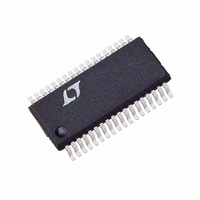LTC3731HG Linear Technology, LTC3731HG Datasheet - Page 13

LTC3731HG
Manufacturer Part Number
LTC3731HG
Description
IC REG SW SYNC 3PH STPDWN 36SSOP
Manufacturer
Linear Technology
Series
PolyPhase®r
Type
Step-Down (Buck)r
Specifications of LTC3731HG
Internal Switch(s)
No
Synchronous Rectifier
Yes
Number Of Outputs
1
Voltage - Output
0.6 ~ 6 V
Frequency - Switching
225kHz ~ 680kHz
Voltage - Input
4 ~ 36 V
Operating Temperature
-40°C ~ 140°C
Mounting Type
Surface Mount
Package / Case
36-SSOP
Lead Free Status / RoHS Status
Contains lead / RoHS non-compliant
Current - Output
-
Power - Output
-
Lead Free Status / Rohs Status
Not Compliant
Available stocks
Company
Part Number
Manufacturer
Quantity
Price
Part Number:
LTC3731HG
Manufacturer:
LINEAR/凌特
Quantity:
20 000
Part Number:
LTC3731HG#PBF
Manufacturer:
LINEAR/凌特
Quantity:
20 000
Part Number:
LTC3731HG#TRPBF
Manufacturer:
LINEAR/凌特
Quantity:
20 000
APPLICATIO S I FOR ATIO
In a PolyPhase converter, the net ripple current seen by the
output capacitor is much smaller than the individual
inductor ripple currents due to the ripple cancellation. The
details on how to calculate the net output ripple current
can be found in Application Note 77.
Figure 4 shows the net ripple current seen by the output
capacitors for the different phase configurations. The
output ripple current is plotted for a fixed output voltage as
the duty factor is varied between 10% and 90% on the
x-axis. The output ripple current is normalized against the
inductor ripple current at zero duty factor. The graph can
be used in place of tedious calculations. As shown in
Figure 4, the zero output ripple current is obtained when:
So the number of phases used can be selected to minimize
the output ripple current and therefore the output ripple
voltage at the given input and output voltages. In applica-
tions having a highly varying input voltage, additional
phases will produce the best results.
Accepting larger values of ∆I
inductances but can result in higher output voltage ripple.
A reasonable starting point for setting ripple current is
∆I
I
∆I
inductor ripple currents are constant determined by the
input and output voltages, and the inductance.
Inductor Core Selection
Once the value for L1 to L3 is determined, the type of
inductor must be selected. High efficiency converters
generally cannot afford the core loss found in low cost
powdered iron cores, forcing the use of ferrite, molyper-
malloy or Kool Mµ
of core size for a fixed inductor value, but it is very
dependent on inductance selected. As inductance in-
creases, core losses go down. Unfortunately, increased
inductance requires more turns of wire and therefore
copper losses will increase.
OUT
L
L
V
= 0.4(I
occurs at the maximum input voltage. The individual
V
OUT
is the total load current. Remember, the maximum
IN
=
OUT
N
k
)/N, where N is the number of channels and
where k
®
U
cores. Actual core loss is independent
= 1 2
U
, , ..., –
L
allows the use of low
N
W
1
U
Ferrite designs have very low core loss and are preferred
at high switching frequencies, so design goals can
concentrate on copper loss and preventing saturation.
Ferrite core material saturates “hard,” which means that
inductance collapses abruptly when the peak design
current is exceeded. This results in an abrupt increase in
inductor ripple current and consequent output voltage
ripple. Do not allow the core to saturate!
Molypermalloy (from Magnetics, Inc.) is a very good, low
loss core material for toroids, but it is more expensive than
ferrite. A reasonable compromise from the same manu-
facturer is Kool Mµ. Toroids are very space efficient,
especially when you can use several layers of wire. Be-
cause they lack a bobbin, mounting is more difficult.
However, designs for surface mount are available which
do not increase the height significantly.
Power MOSFET and D1, D2, D3 Selection
At least two external power MOSFETs must be selected for
each of the three output sections: One N-channel MOSFET
for the top (main) switch and one or more N-channel
MOSFET(s) for the bottom (synchronous) switch. The
number, type and “on” resistance of all MOSFETs selected
take into account the voltage step-down ratio as well as the
actual position (main or synchronous) in which the MOS-
FET will be used. A much smaller and much lower input
capacitance MOSFET should be used for the top MOSFET
Figure 4. Normalized Peak Output Current
vs Duty Factor [I
1.0
0.9
0.8
0.7
0.6
0.5
0.4
0.3
0.2
0.1
0
0.1
0.2
0.3
DUTY FACTOR (V
0.4
RMS
0.5
= 0.3(I
OUT
0.6
/V
O(P-P)
IN
0.7
1-PHASE
2-PHASE
3-PHASE
4-PHASE
6-PHASE
12-PHASE
)
LTC3731H
0.8
]
3731H F04
0.9
13
3731hfa













